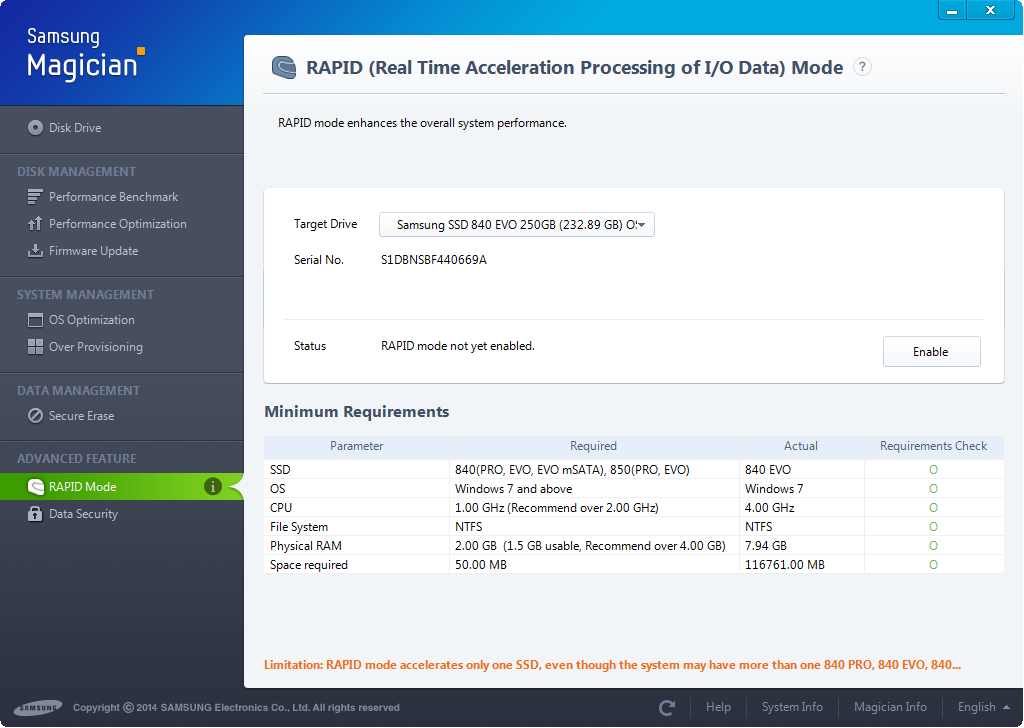Samsung’s Magician Rapid Mode

When benchmarking the eMachines EL1300 that was getting donated for a good cause, something was immediately noticed, it wasn’t hard to miss considering the bar in the chart was higher then any other one.
When viewing the results from PCMark Vantage, I couldn’t believe the HDD Score, Turns out apparently it was Samsung’s Magician Rapid Mode that was enabled causing and insane HDD Score. No ones complaining and with such a score it’s beneficial to have enabled but comes with a price, Risk and System resources.
RAPID mode stands for (Real-time Accelerated Processing of I/O Data). RAPID is designed to further improve the performance of an SSD and not make a HDD more SSD-like. RAPID uses some of your system memory and CPU resources to cache hot data, serving it out of DRAM rather than your SSD. Basically it’s PCIe-like Performance from a SATA SSD. Guess this will be the closest I’ll get to a PCIe SSD, would really love to have GSKILL Phoenix Blade 480GB PCIe SSD, for now it’s noting more then a dream.

The cache resides in main memory and is allocated out of non-paged kernel memory. In fact, that’s the easiest way to determine whether or not RAPID is actually working – you’ll see non-paged kernel memory jump in size after about a minute of idle time on your machine:

Presently RAPID will use no more than 25% of system memory or 1GB, whichever comes first. Both reads and writes are cached, but in different ways. The read cache works as you’d expect, while RAPID more accurately does something like buffering/combining for writes. Reads are simple to cache (just look at what addresses are frequently accessed and draw those into the cache), but writes offer a different set of challenges.
If you write to DRAM first and write back to the SSD you run the risk of losing a ton of data in the event of a crash or power failure. Although RAPID obeys flush commands, there’s always the risk that anything pending could be lost in a system crash. Recognizing this potential, Samsung’s RAPID mode tries to instead focus on combining low queue depth writes into much larger bundles of data that can be written more like large transfers across many NAND die.
The potential performance upside is tremendous. While the EVO is ultimately limited by the performance of 6Gbps SATA, any requests serviced out of main memory are limited by the speed of your DRAM.
So now that you understand the ups and downs to what (Real-time Accelerated Processing of I/O Data) can do for you when enabling the feature in Samsung’s Magician Software. You can fine even more information on a really well written article on Anandtech, of course that’s were I found the above rundown on Magician RAPID Mode. Here’s the numbers that came back from PCMark Vantage with RAPID Mode disabled and enabled.
Starting with RAPID Mode Disabled, PCMark Vantage HDD Scored 52141 really not all that exciting but when comparing it to the Mechanic HDD in the eMahinces EL1300 there’s something to be said, like did we really put up with such performance back in the days. With RAPID Mode Enabled PCMark Vantage HDD Scored 86314 now there’s something to excited about, even more so when looking at the eMachines Score.
There’s just one thing that stands out the most about Samsung RAPID Mode when it’s Enabled, the risk that anything pending could be lost in a system crash when writing to DRAM first and write back to the SSD. Even though the 840 EVO comes ready with tantalum capacitors (power loss protection) which in the event of power loss should keep the drive powered long enough to save your data, it’s not going to work when RAPID mode is enabled because of it been stored in system memory, it would have to be awful fast in the risk of a power failure to save the data.
Nevertheless if your gamer like myself your definitely benefit from RAPID Mode example with Crysis 3, before updating to v4.5 Magician reported that RAPID Mode had to be disabled before installing the newer version and did so. When the time came to load Crysis 3 is was noticed right away and said oh that’s right RAPID Mode is disabled, so there you have it plus were talking about Crysis 3 here one game I wouldn’t want to play off a Mechanic HDD.

PhoneyVirus
Has a passion for computer hardware and dream’s of been a professional technician one day, fairly educated on the subject and opened minded. Programing maybe one of many interest but are divided into what you call time. When he ant learning what’s new, he’s usually jamming out on electric guitar or playing some awesome PC Game.